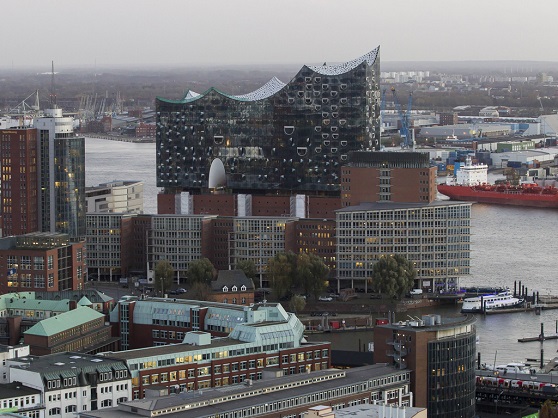
The building of the Elbe Philharmonic Hall in Hamburg is set to become an icon of the city
 |
| source: http://www.hamburg.de/elbphilharmonie/ |
Berlin/Hamburg - The roof of the Elbphilharmonie in Hamburg resembles the turbulent surface of the nearby North Sea, which opens to the public on Wednesday. This striking building in the heart of the old Hamburg port, which is set to become a new icon of Germany's second-largest city, draws attention not only from the outside but also impresses with its internal layout and interior design.
"We wanted people to maintain contact with the water and the wind," says architect Jan-Christoph Lindert at one of the niches in the building's glass facade, which offers visitors a view of the vast harbor and the chance to experience truly maritime weather at any time.
The seriousness of the statement about contact with water is demonstrated by the very location of the Elbphilharmonie, which is surrounded by the Elbe River on three sides and where sightseeing boats regularly pass by. In order to withstand floods that frequently reach Germany from the Czech Republic, the building stands 8.5 meters above the usual water level of the river. It has been structured so that water can never reach the most important areas - the two concert halls.
These are located in an extension of the original six-story red-brick warehouse. "The idea was that the warehouse would have spaces for ancillary use and that beyond the roof of the warehouse, access would lead to the main areas," explains Lindert, who has been involved in the construction for the past few years.
In the former warehouse, which is still bordered on one side by old port cranes, there is now a hotel with 244 rooms, 44 private apartments, a restaurant, and a parking garage with over 500 spaces, the spiral design of which may remind many of the interior of the famous Guggenheim Museum in New York.
The path into the interior of the building, which cost 789 million euros (21.3 billion crowns), is shown by unique 82-meter long curved escalators, where visitors begin to perceive the scale of the construction better. "The building is actually huge, over 100 meters long, 110 meters high at the western peak and 85 meters high at the eastern peak," says the architect from the Swiss firm Herzog & de Meuron about the philharmonic, which has an almost triangular shape when viewed from above.
Visitors will feel the size of the building even more keenly on the series of stairs that await them before they reach one of the concert halls. The first set leads them to a viewing platform located between the original warehouse building and the magnificent glass extension. After opening the enormous doors made of corrugated glass, they can walk around the entire building 37 meters above ground, partly sheltered by the extension and enjoy views of the harbor and the city.
Above the platform level are both concert halls, which can be accessed through additional stairs, this time hidden in a white spiral tube. The large concert hall accommodates 2100 listeners, none of whom sits more than 30 meters away from the conductor. "The nice and special thing is that it is possible to reach every seat in the hall without having to go out of it," notes Lindert, pointing to a trio of mutually connected spirals that weave through various levels for the audience.
In the beige hall filled with rapidly rising rows of gray upholstered chairs, visitors will certainly also notice an object hovering above their heads. A huge circle hanging from the ceiling aids in the even better distribution of sound. The acoustics should be of the highest quality, also thanks to specially curved walls and double soundproofing.
This is to prevent sounds, such as the noise of ship sirens, from penetrating the hall. However, the building had to respond to its harbor surroundings in other ways as well. More than 16,000 square meters of the vast glass facade have been printed with special dots, which assist ships' radars with orientation. "If ships did not perceive this, they would crash into the building," adds Lindert, stating that the architects did not wish for such a close connection with the local maritime elements.
The English translation is powered by AI tool. Switch to Czech to view the original text source.
0 comments
add comment
Related articles
0
11.01.2019 | The complex of the Elbe Philharmonic is a magnet for visitors
0
10.01.2018 | A year ago, the Elbphilharmonie building was opened in Hamburg
0
10.01.2017 | On Wednesday, the Elbphilharmonie building will open in Hamburg
0
01.11.2016 | In Hamburg, the Elbphilharmonie building was completed
0
28.04.2016 | After years of delays, the Elbphilharmonie will open in Hamburg in January
0
03.04.2007 | Hamburg is building a new landmark - the Elbe Philharmonic Hall by HdeM











